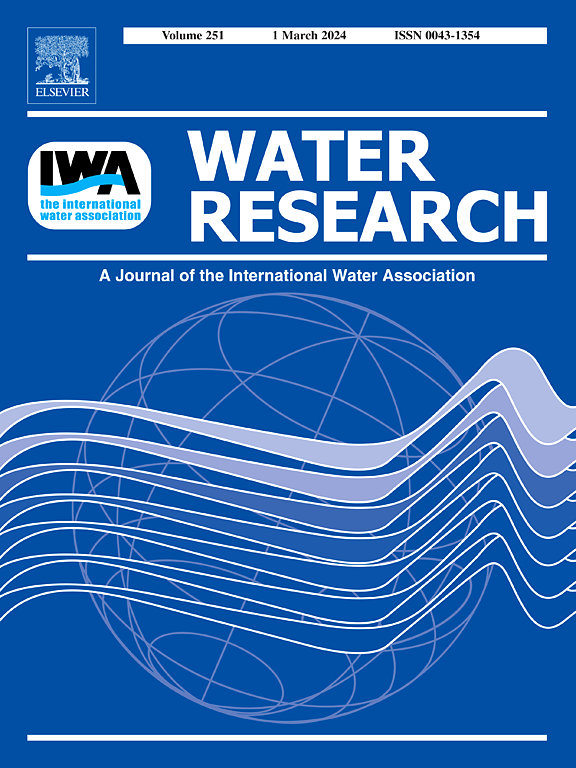苦味酸在铁(III)/过碘酸过程中促进有机污染物的去除:机理以及去除效率与污染物结构之间的关系
IF 11.4
1区 环境科学与生态学
Q1 ENGINEERING, ENVIRONMENTAL
引用次数: 0
摘要
铁催化高碘酸盐(PI)工艺的应用往往受到适用 pH 值范围窄和铁(III)与氧化剂反应弱的限制。本文采用可生物降解的吡啶甲酸(PICA)作为一种螯合配体(CLs),在初始 pH 值为 3.0-8.0 的条件下增强对有机污染物(OPs)的去除,在 Fe(III)/PI 过程中显示出优于其他 CLs 的特性。通过淬灭、亚砜探针转化和 18O 同位素标记测试,Fe(III)-PICA/PI 过程中产生的主要反应物是高价铁氧自由基(FeIV=O)和羟自由基(-OH)。FeIV=O 和 -OH 的相对贡献取决于 OPs 的电离势(IP)和能隙(ΔE)。OPs 的降解也与其结构直接相关,表观速率常数与最高占据分子轨道能(EHOMO)、IP 和 ΔE 有很好的相关性,其中 ΔE 的影响更大。此外,Fe(III)-PICA 复合物对实际水基质中 OPs 的去除显示出卓越的长期有效性,同时 PI 的转化也是无毒的,这表明 Fe(III)-PICA/PI 工艺具有广阔的应用前景。本研究为提高 Fe(III)/PI 工艺的性能提供了一种有效的方法,并揭示了去除效率与污染物结构之间的机理和关系。本文章由计算机程序翻译,如有差异,请以英文原文为准。

Picolinic acid promotes organic pollutants removal in Fe(III)/periodate process: Mechanism and relationship between removal efficiency and pollutant structure
The application of Fe-catalyzed periodate (PI) processes is often limited by both the narrow applicable pH range and weak reaction between Fe(III) and oxidant. Here, the biodegradable picolinic acid (PICA) was used as one kind of chelating ligands (CLs) to enhance the removal of organic pollutants (OPs) at initial pH 3.0−8.0, which displayed superior properties than the other CLs in Fe(III)/PI process. The dominant reactive species produced in the Fe(III)-PICA/PI process turned out to be high-valent iron-oxo (FeIV=O) species and hydroxyl radical (•OH) by quenching, sulfoxide probe transformation, and 18O isotope-labeling tests. The relative contribution of FeIV=O and •OH was dependent on OPs ionization potential (IP) and energy gap (ΔE). The degradation of OPs was also directly associated with their structure, the apparent rate constants correlated well with the highest occupied molecular orbital energy (EHOMO), IP, and ΔE, and among them ΔE had a greater effect. Furthermore, Fe(III)-PICA complexes displayed excellent long-term effectiveness for OPs removal in actual water matrixes, along with the non-toxic conversion of PI, indicating a broad application perspective of Fe(III)-PICA/PI process. This study provides an efficient method to improve the performance of Fe(III)/PI process and reveals the mechanism and relationship between removal efficiency and pollutant structure.
求助全文
通过发布文献求助,成功后即可免费获取论文全文。
去求助
来源期刊

Water Research
环境科学-工程:环境
CiteScore
20.80
自引率
9.40%
发文量
1307
审稿时长
38 days
期刊介绍:
Water Research, along with its open access companion journal Water Research X, serves as a platform for publishing original research papers covering various aspects of the science and technology related to the anthropogenic water cycle, water quality, and its management worldwide. The audience targeted by the journal comprises biologists, chemical engineers, chemists, civil engineers, environmental engineers, limnologists, and microbiologists. The scope of the journal include:
•Treatment processes for water and wastewaters (municipal, agricultural, industrial, and on-site treatment), including resource recovery and residuals management;
•Urban hydrology including sewer systems, stormwater management, and green infrastructure;
•Drinking water treatment and distribution;
•Potable and non-potable water reuse;
•Sanitation, public health, and risk assessment;
•Anaerobic digestion, solid and hazardous waste management, including source characterization and the effects and control of leachates and gaseous emissions;
•Contaminants (chemical, microbial, anthropogenic particles such as nanoparticles or microplastics) and related water quality sensing, monitoring, fate, and assessment;
•Anthropogenic impacts on inland, tidal, coastal and urban waters, focusing on surface and ground waters, and point and non-point sources of pollution;
•Environmental restoration, linked to surface water, groundwater and groundwater remediation;
•Analysis of the interfaces between sediments and water, and between water and atmosphere, focusing specifically on anthropogenic impacts;
•Mathematical modelling, systems analysis, machine learning, and beneficial use of big data related to the anthropogenic water cycle;
•Socio-economic, policy, and regulations studies.
 求助内容:
求助内容: 应助结果提醒方式:
应助结果提醒方式:


